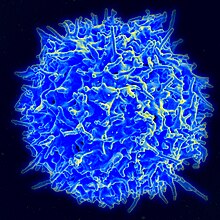| Adult T-cell leukemia/lymphoma | |
|---|---|
 | |
| Human T-cell(normal) | |
| Specialty | Oncology, hematology |
Adult T-cell leukemia/lymphoma (ATL or ATLL) is a rare cancer of the immune system's T-cells[1][2][3] caused by human T cell leukemia/lymphotropic virus type 1 (HTLV-1).[4] All ATL cells contain integrated HTLV-1 provirus further supporting that causal role of the virus in the cause of the neoplasm.[4] A small amount of HTLV-1 individuals progress to develop ATL with a long latency period between infection and ATL development. ATL is categorized into 4 subtypes: acute, smoldering, lymphoma-type, chronic. Acute and Lymphoma-type are known to particularly be aggressive with poorer prognosis.[5]
Globally, the retrovirus HTLV-1 is estimated to infect 20 million people per year with the incidence of ATL approximately 0.05 per 100,000 per year with endemic regions such as regions of Japan, as high as 27 per 100,000 per year.[6] However, cases have increased in non-endemic regions with highest incidence of HTLV-1 in southern/northern islands of Japan, Caribbean, Central and South America, intertropical Africa, Romania, northern Iran. ATL normally occurs around the age of 62 years but median age at diagnosis does depend on prevalence of the HTLV-1 infection in the geographic location.[7]
Current treatment regiments for ATL are based on clinical subtype and response to initial therapy. Some therapy modalities for treatment may not available in all countries therefore strategies differ across the world. All patients are referred to clinical trials if available. Beyond clinical trials, treatments are centered on multiagent chemotherapy, zidovudine plus interferon a (AZT/IFN), and allogenic hematopoietic stem cell transplantation (alloHSCT).[6]
- ^ Yodoi, J; Takatsuki, K; Masuda, T (1974). "Letter: Two cases of T-cell chronic lymphocytic leukemia in Japan". New England Journal of Medicine. 290 (10): 572–3. doi:10.1056/NEJM197403072901018. PMID 4544052.
- ^ Uchiyama, T; Yodoi, J; Sagawa, K; Takatsuki, K; Uchino, H (1977). "Adult T-cell leukemia: Clinical and hematologic features of 16 cases". Blood. 50 (3): 481–92. doi:10.1182/blood.V50.3.481.481. PMID 301762.
- ^ Yodoi, J; Maeda, M (2011). "The discovery of ATL: an odyssey in restrospect". International Journal of Hematology. 94 (5): 423–8. doi:10.1007/s12185-011-0957-x. PMID 22068231. S2CID 9299403.
- ^ a b Nicot, Christophe (2005). "Current views in HTLV-I-associated adult T-cell leukemia/lymphoma". American Journal of Hematology. 78 (3): 232–9. doi:10.1002/ajh.20307. PMID 15726602. S2CID 30160899.
- ^ Matsuoka, M; Jeang, K (2007). "Human T-cell leukaemia virus type 1 (HTLV-1) infectivity and cellular transformation". Nature Reviews Cancer. 7 (4): 270–280. doi:10.1038/nrc2111. ISSN 1474-175X. PMID 17384582. S2CID 7824653.
- ^ a b Phillips, A; Harewood, J (2018). "Adult T Cell Leukemia-Lymphoma (ATL): State of the Art". Current Hematologic Malignancy Reports. 13 (4): 300–307. doi:10.1007/s11899-018-0458-6. ISSN 1558-822X. PMID 30047026. S2CID 51719877.
- ^ Chihara, D; Ito, H; Katanoda, K; Shibata, A; Matsuda, T; Tajima, K; Sobue, T; Matsuo, K (2012). "Increase in incidence of adult T-cell leukemia/lymphoma in non-endemic areas of Japan and the United States". Cancer Science. 103 (10): 1857–1860. doi:10.1111/j.1349-7006.2012.02373.x. ISSN 1349-7006. PMC 7659271. PMID 22738276.